What are the common commands for keys and strings in Redis?
Redis related knowledge
The default port number of Redis is 6379
The default 16 databases, similar array subscripts start from 0, The initial default is to use library No. 0.
Use the command select <dbid></dbid> to switch databases. Such as: select 8.
Unified password management, all libraries have the same password.
dbsizeView the number of keys in the current database. flushdbClear the current library. flushall Kill all libraries.
Redis is a single-threaded multi-channel IO multiplexing technology.
Multiplexing refers to using one thread to check the readiness status of multiple file descriptors (Socket), such as calling the select and poll functions and passing in multiple file descriptors. If one file descriptor is ready, then Return, otherwise block until timeout. After getting the ready state, the actual operation can be performed in the same thread, or thread execution can be started (such as using a thread pool).
Serial VS Multi-thread lock (memcached) VS Single-threaded multi-channel IO multiplexing(Redis)
Redis and Memcache Three differences:
Support multiple data types
Support persistence
Single thread multiple Road IO multiplexing
Data types in Redis
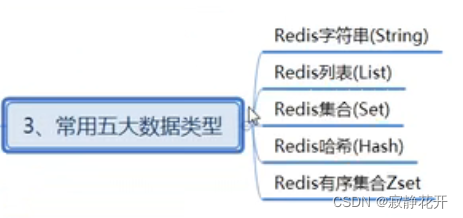
redis key
keys *: View all keys in the current library (matching: keys *1)
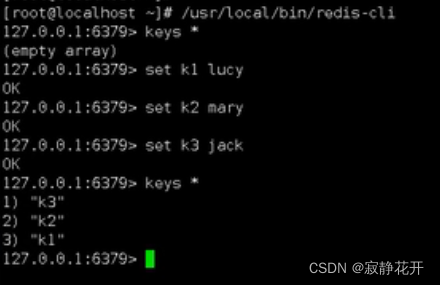
##exists key: Determine whether a key exists.
type key: Check what type your key is.
del key: Delete the specified key data,
unlink key: Select non-blocking deletion based on value. Only keys are deleted from keyspace metadata, and the actual deletion will be performed asynchronously later. .
expire key 10: 10 seconds, set the expiration time for the given key,
ttl key: Check how many seconds there are left to expire, -1 means never Expired, -2 means expired.
selectCommand to switch databases,
dbsizeView the number of keys in the current database.
flushdbClear the current library.
flushallkill all libraries
String type is binary safe. It means that Redis string can contain any data. For example, jpg pictures
or serialized objects.
String type is the most basic data type of Redis. A string value in Redis can be up to 512M.
set : Add key-value pairs. When a key with a set value is set to a new value, the new value will overwrite the old one.

*NX: When the key does not exist in the database, the key-value can be added to the database.*XX: When the key exists in the database, key-value can be added to the database, which is mutually exclusive with NX parameters.
*EX: Key timeout seconds.
*PX: key’s timeout in milliseconds, mutually exclusive with EX.
get Query the corresponding key value.
append Append the given Append to the end of the original value,
strlen Get the length of the value.
setnx Set the value of the key only when the key does not exist.
incrIncrease the numerical value stored in key by 1.
Can only operate on numeric values. If it is empty, the new value is 10
decrDecrease the numeric value stored in key by 1 .
Can only operate on numeric values. If it is empty, the new value is -1.
inrjy/ decrby <step> Increase or decrease the numerical value stored in key. Custom step size. </step>
incr and decr are atomic operations
but i in java is not an atomic operation
msetSet one or more key-value pairs at the same time.....
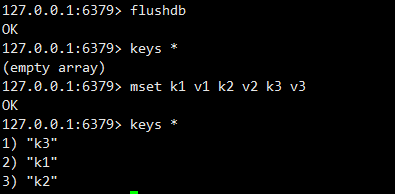
Get one or more values at the same time.
msetnx
It is atomic
Set one or more key-value pairs at the same time ,succeeds if and only if all given keys do not exist.
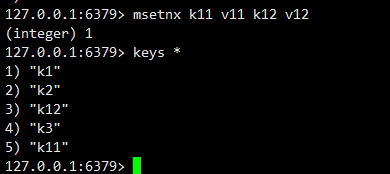
If one of them exists before, it will not succeed

getrange, setrange
getrange
Get the range of values, similar to substring in java, front package, back package
setrange
Overwrites the stored string value with, starting from 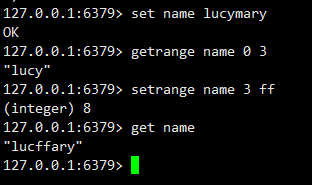
setex
While setting the key value, set the expiration time in seconds.
 ##Replace the old value
##Replace the old value
Replace the old value with the new one, The new value is set and the old value is obtained.
 String data structure
String data structureSDS is the abbreviation of String data structure, which represents the data structure of a simple dynamic string. It is a string that can be modified. The internal structure is similar to Java's ArrayList. It uses pre-allocated redundant space to reduce frequent allocation of memory.
 #The internal space capacity is usually larger than the actual string length len, as shown in the figure. If the string length is less than 1M, the existing space will be doubled when expanding. But if the length exceeds 1M, only 1M of space will be added each time it is expanded. It should be noted that the maximum length of the string is 512M.
#The internal space capacity is usually larger than the actual string length len, as shown in the figure. If the string length is less than 1M, the existing space will be doubled when expanding. But if the length exceeds 1M, only 1M of space will be added each time it is expanded. It should be noted that the maximum length of the string is 512M.
The above is the detailed content of What are the common commands for keys and strings in Redis?. For more information, please follow other related articles on the PHP Chinese website!

Hot AI Tools

Undresser.AI Undress
AI-powered app for creating realistic nude photos

AI Clothes Remover
Online AI tool for removing clothes from photos.

Undress AI Tool
Undress images for free

Clothoff.io
AI clothes remover

Video Face Swap
Swap faces in any video effortlessly with our completely free AI face swap tool!

Hot Article

Hot Tools

Notepad++7.3.1
Easy-to-use and free code editor

SublimeText3 Chinese version
Chinese version, very easy to use

Zend Studio 13.0.1
Powerful PHP integrated development environment

Dreamweaver CS6
Visual web development tools

SublimeText3 Mac version
God-level code editing software (SublimeText3)

Hot Topics
 How to build the redis cluster mode
Apr 10, 2025 pm 10:15 PM
How to build the redis cluster mode
Apr 10, 2025 pm 10:15 PM
Redis cluster mode deploys Redis instances to multiple servers through sharding, improving scalability and availability. The construction steps are as follows: Create odd Redis instances with different ports; Create 3 sentinel instances, monitor Redis instances and failover; configure sentinel configuration files, add monitoring Redis instance information and failover settings; configure Redis instance configuration files, enable cluster mode and specify the cluster information file path; create nodes.conf file, containing information of each Redis instance; start the cluster, execute the create command to create a cluster and specify the number of replicas; log in to the cluster to execute the CLUSTER INFO command to verify the cluster status; make
 How to read redis queue
Apr 10, 2025 pm 10:12 PM
How to read redis queue
Apr 10, 2025 pm 10:12 PM
To read a queue from Redis, you need to get the queue name, read the elements using the LPOP command, and process the empty queue. The specific steps are as follows: Get the queue name: name it with the prefix of "queue:" such as "queue:my-queue". Use the LPOP command: Eject the element from the head of the queue and return its value, such as LPOP queue:my-queue. Processing empty queues: If the queue is empty, LPOP returns nil, and you can check whether the queue exists before reading the element.
 How to clear redis data
Apr 10, 2025 pm 10:06 PM
How to clear redis data
Apr 10, 2025 pm 10:06 PM
How to clear Redis data: Use the FLUSHALL command to clear all key values. Use the FLUSHDB command to clear the key value of the currently selected database. Use SELECT to switch databases, and then use FLUSHDB to clear multiple databases. Use the DEL command to delete a specific key. Use the redis-cli tool to clear the data.
 How to configure Lua script execution time in centos redis
Apr 14, 2025 pm 02:12 PM
How to configure Lua script execution time in centos redis
Apr 14, 2025 pm 02:12 PM
On CentOS systems, you can limit the execution time of Lua scripts by modifying Redis configuration files or using Redis commands to prevent malicious scripts from consuming too much resources. Method 1: Modify the Redis configuration file and locate the Redis configuration file: The Redis configuration file is usually located in /etc/redis/redis.conf. Edit configuration file: Open the configuration file using a text editor (such as vi or nano): sudovi/etc/redis/redis.conf Set the Lua script execution time limit: Add or modify the following lines in the configuration file to set the maximum execution time of the Lua script (unit: milliseconds)
 How to use the redis command line
Apr 10, 2025 pm 10:18 PM
How to use the redis command line
Apr 10, 2025 pm 10:18 PM
Use the Redis command line tool (redis-cli) to manage and operate Redis through the following steps: Connect to the server, specify the address and port. Send commands to the server using the command name and parameters. Use the HELP command to view help information for a specific command. Use the QUIT command to exit the command line tool.
 How to set the redis expiration policy
Apr 10, 2025 pm 10:03 PM
How to set the redis expiration policy
Apr 10, 2025 pm 10:03 PM
There are two types of Redis data expiration strategies: periodic deletion: periodic scan to delete the expired key, which can be set through expired-time-cap-remove-count and expired-time-cap-remove-delay parameters. Lazy Deletion: Check for deletion expired keys only when keys are read or written. They can be set through lazyfree-lazy-eviction, lazyfree-lazy-expire, lazyfree-lazy-user-del parameters.
 How to optimize the performance of debian readdir
Apr 13, 2025 am 08:48 AM
How to optimize the performance of debian readdir
Apr 13, 2025 am 08:48 AM
In Debian systems, readdir system calls are used to read directory contents. If its performance is not good, try the following optimization strategy: Simplify the number of directory files: Split large directories into multiple small directories as much as possible, reducing the number of items processed per readdir call. Enable directory content caching: build a cache mechanism, update the cache regularly or when directory content changes, and reduce frequent calls to readdir. Memory caches (such as Memcached or Redis) or local caches (such as files or databases) can be considered. Adopt efficient data structure: If you implement directory traversal by yourself, select more efficient data structures (such as hash tables instead of linear search) to store and access directory information
 How to implement redis counter
Apr 10, 2025 pm 10:21 PM
How to implement redis counter
Apr 10, 2025 pm 10:21 PM
Redis counter is a mechanism that uses Redis key-value pair storage to implement counting operations, including the following steps: creating counter keys, increasing counts, decreasing counts, resetting counts, and obtaining counts. The advantages of Redis counters include fast speed, high concurrency, durability and simplicity and ease of use. It can be used in scenarios such as user access counting, real-time metric tracking, game scores and rankings, and order processing counting.






